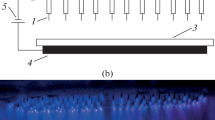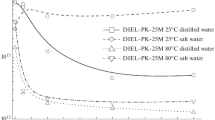Summary
Conditions of formation and stability of „frost effect” on layer of polystyrene with a very thin surface film prepared by crosslinking in an electric discharge were studied for different starting electric potentials of the surface. It was found that during the rise of the temperature of the sample the surface potential falls and a stable frost exists in a certain temperature interval. The explanation of the observed phenomena is based on Cressman's expression for electrocapillar effect and on effects connected with dilatation of the basic layer and artificial film on its surface.
Similar content being viewed by others
References
BIKERMAN, J.J.: Surface Chemistry, Academic Press Inc., New York 1958
BUDD, H.F.: J.Appl. Phys. 36, 1613 (1965)
CRESSMAN, P.J.: J. Appl. Phys. 34, 2327 (1963)
NICOLL, F.H.: RCA Rev. 25, 209 (1964)
VINOKUROVA, I.N. and CHERKASOV, J.A.: Zhurnal nauchnoy i prikladnoy fotografiy i kinematografiy 24, 424 (1979)
Author information
Authors and Affiliations
Rights and permissions
About this article
Cite this article
Ulbert, K., Chudáček, I. & Slavínská, D. Behaviour of a thermoplastic charged surface in the vicinity of the softening point. Polymer Bulletin 8, 179–185 (1982). https://doi.org/10.1007/BF00263025
Received:
Accepted:
Issue Date:
DOI: https://doi.org/10.1007/BF00263025




